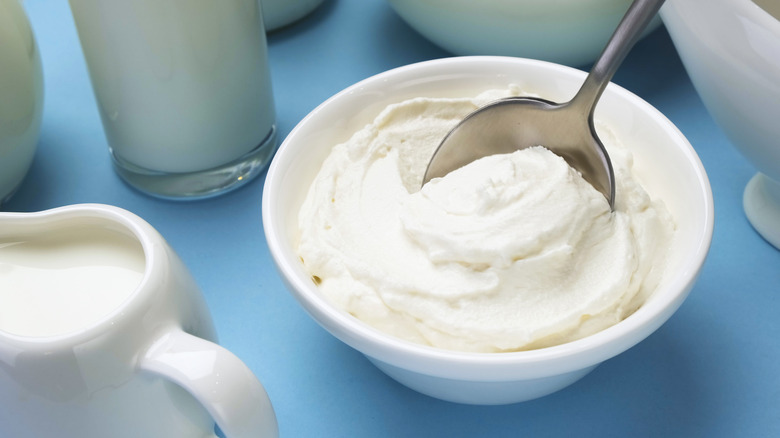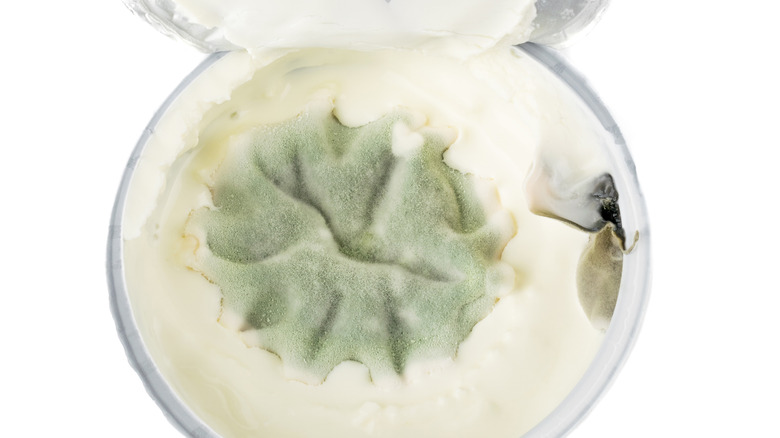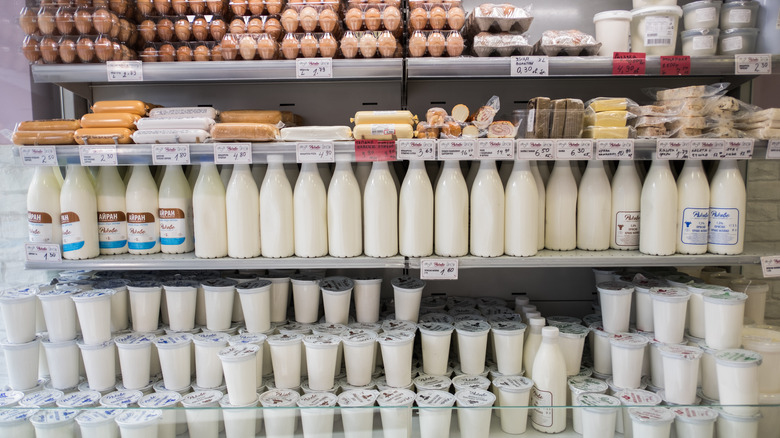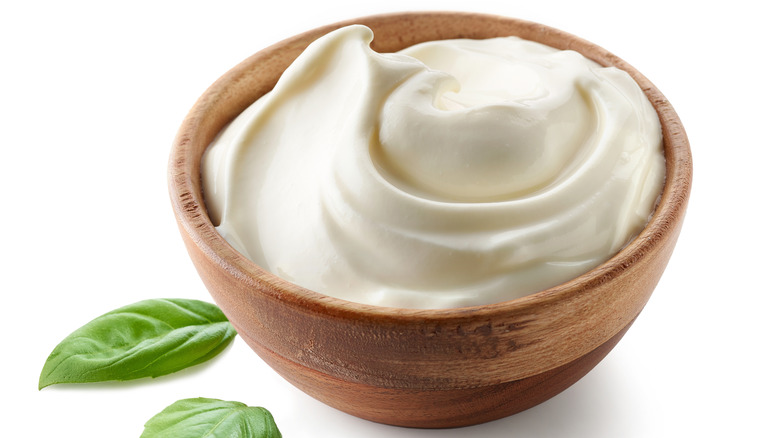How To Tell If Sour Cream Has Gone Bad
Even if it may cost a little extra at Chipotle, it's worth the money. Sour cream elevates every dish it touches. From being a best friend to baked potatoes and a tangy topping to cheesy nachos all the way to that hidden ingredient in a cake mix that makes for a super tender crumb, sour cream has been having a moment for a while now and we're completely OK with it. According to Cook's Illustrated, it gets its tangy, slightly tart, addictive flavor through a process where lactic acid-producing bacteria is added to dairy cream. Alas, a dollop of Daisy was born.
Unfortunately, all delicious things eventually go bad (besides honey, that is, which is practically immortal). Often, we will search for a sour smell when checking the quality of dairy — the problem is, sour cream already smells sour. Are we left with no choice but to taste it? Luckily, there's another way to check that tub of sour cream to see if it's good for another go or if it's gone bad, leaving you to make a grocery run.
Look for discoloration or mold
Instead of taking a bite from a risky tub of sour cream to confirm whether or not it's gone bad, just look at it. Your eyes are the best instruments, especially with an already sour substance (though, it should be noted that, according to DoesItGoBad, spoiled sour cream will have a detectably off smell. It'll smell different from the normal "sour" smell of sour cream).
As for what to look for, Eat By Date states that once the water separates, and a pool starts to form at the surface, your sour cream only has a few good days left. Soon after, mold will form in dark spots, which means it's gone bad and it's time to toss. Now that we know what to look out for, why does sour cream get watery in the first place?
That watery substance floating at the top is actually known as "whey." Containing all nine essential amino acids (per Medical News Today), rich in calcium, and packed with protein, this unsightly liquid should be the least of your worries. In fact, it occurs because anytime you dip your spoon, a chip, or that cheesy quesadilla into a tub of sour cream, the milk's cell walls break and whey releases liquid, which rises to the top. It's completely edible, safe to stir back in, and is only unsafe once dark mold is present (which is very noticeable once it starts to form).
Check the sell-by and use-by dates
The expiration date on the sour cream container is a huge helper as well. While it may not be foolproof, it's a go-to reference for when you're not so sure if your sour cream has turned bad.
Another thing that can get confusing, however, is the sell-by date versus the use-by date. Sell-by has less to do with safety and is more of a rule of thumb stores use when the product is no longer at optimal freshness, per the Food Safety and Inspection Service. Use-by is for us, the consumers. This tells us a rough estimate of when that peak window ends. Once it's over, it's up to our judgment on how safe the product is to consume. As for sour cream, specifically, the USDA says it can be good for up to three weeks past the sell-by date if refrigerated.
How to prolong the use-by date of our sour cream? First things first, always make sure your refrigerator is set at the right temperature, which is at or below 40 degrees F. Once you peel back the paper on your tub of sour cream, chill it immediately in a separate airtight container or in its original packaging with the lid on. Also, it's very important to use clean utensils when scooping out sour cream for serving, due to the possibility of cross-contamination. Tidbits of refried beans, avocado, and whatever else you might introduce to the sour cream with a used spoon could speed up the spoiling process (via Eat By Date).
Stave off a bad tub of sour cream
A little-known trick shared by Country Living for preventing bacterial populations from growing on dairy products, like sour cream, is to store the container upside down in the refrigerator. The reason? Oxygen. The space between the surface of sour cream to the top of the lid allows small amounts of oxygen to seep through, resulting in bacterial growth.
Flipping the container over creates a vacuum, making it nearly impossible for stubborn bacteria to get inside and turn your sour cream bad. On top of that, it's already stored at a temperature where bacteria growth is extremely slow. Not only does this work for sour cream, but cottage cheese as well. The kicker is pressing the lid on tight or setting it upside down onto a plate, ensuring you won't have a huge mess on your hands.
The bottom line on sour cream is, while it's OK to consume sour cream past the sell-by date, you should use your best judgment past the use-by date. Further, your eyes are your best instruments when it comes to determining if sour cream has gone bad, and upon proper storage, this tangy ingredient can live longer than expected. One final tip? When you don't want to make that last-minute grocery run because you were forced to toss that leftover sour cream tub, check to see if you have these ingredients on hand that can act as sour cream replacements.



